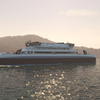Fitch, the international rating agency, has affirmed the Senior Unsecured 'BBB+' and Short-term 'F2' ratings of P&O Princess Cruises (POPC), the world's third largest cruise operator. However, the Rating Outlook is changed to Negative from Stable. While Fitch's ratings continue to reflect POPC's competitive position and financial flexibility, the Negative Outlook expresses concerns about the impact of adverse economic conditions on credit protection measures in the next 12-18 months.
In Fitch's view, POPC is in a good position to seize opportunities in the global cruise market. Demographic factors and the low penetration rate of cruises on a per capita basis support market growth expectations, while POPC enjoys strong brand recognition and a fleet that is both expanding and improving. Having launched the 2,600-berth Golden Princess in May 2001, POPC will take delivery of eight further new vessels by end-2004. As the average age of the fleet falls, the accommodation offers a greater proportion of cabins with balconies, thus meeting the increased demands of customers. P&O Princess is less exposed to the Caribbean, the industry's most competitive geographical sector, than many other cruise companies. It also shows greater diversification in terms of the home countries of its customers. The proportion of customers sourced by Princess Cruises, the company's American operation and from which most of its clients herald, is forecast to fall below 60% in 2004. By the same time, the U.K. and German-focused operations, where the markets are far less mature and where the group enjoys leading positions, are targeted to account for 40 percent of group capacity.
Fleet modernization has paved the way for economies of scale and greater efficiency, with direct ship operating costs falling steadily in relation to passenger numbers. The relocation of POPC's onshore offices has also had a positive impact on expenses.
Compared to the same period in 2000, a 2Q01 a unit cost reduction of 5 percent, and a 1H01 reduction of 3 percent, were ahead of the company's annual 2 percent target. Unit cost reductions have tended to offset the negative impact of a drop in yields (revenues per unit) on operating profit. In 2Q01, with a 5 percent decline in operating costs per unit balancing a 3 percent decline in net yield, operating profit rose by 3 percent. This compares with a 46 percent fall in 1Q01, although the 2000 results in this comparable period was distorted by the Millennium benefit, which similarly affected 1H01 operating profit, down 14.5 percent against the comparable figure for the same period in 2000.
For FY01 as a whole, Fitch expects a 3 percent reduction in costs to mirror a similar decline in yield and for operating profit to remain broadly flat. At the time of demerger (from P&O) in October 2000, P&O Princess showed a healthy capital structure. Net debt to EBITDA of 1.86x (1.25x) and EBITDA net interest cover of 6.8x (12.9x) at end-2000 were comfortably within 'BBB+' parameters.
However, in view of the company's $2.9bn capital commitment, which is not expected to be covered by future internal cash generation (net operating cash flow to gross capex of 0.5x in 2000), Fitch expects leverage and coverage ratios to deteriorate in 2002 and 2003. Moreover, the global increase in cruise industry capacity, which, according to forward ship orders, should average 10 percent per year over the next five years, raises concerns about market oversupply in a time of uncertain economic outlook for consumers in both the US and Europe. Although POPC's capital structure remains sound, these factors cause the Outlook to be revised to Negative. - (Reuters)
Subscribe for
Maritime Reporter E-News
Maritime Reporter E-News is the maritime industry's largest circulation and most authoritative ENews Service, delivered to your Email five times per week










